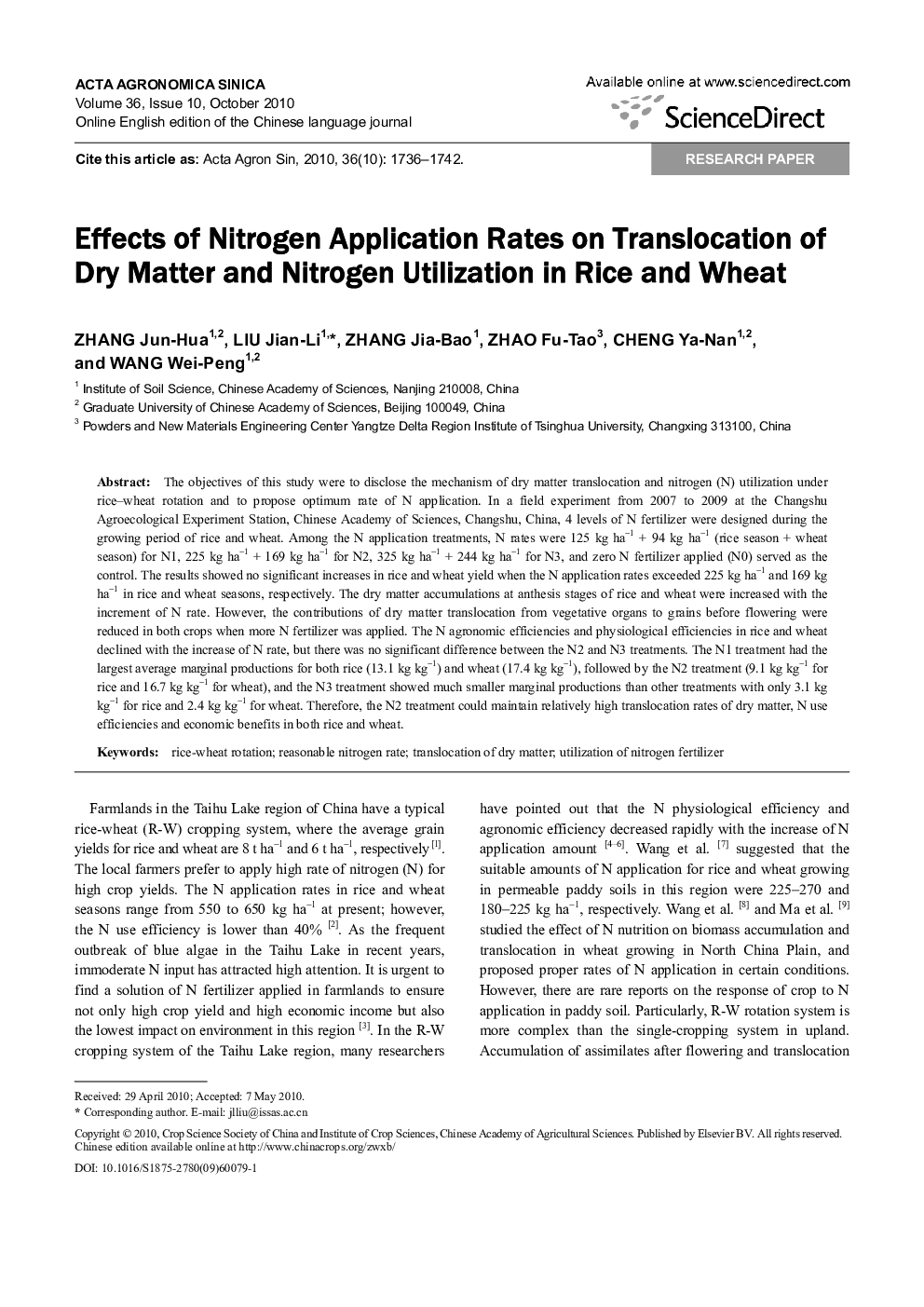| Article ID | Journal | Published Year | Pages | File Type |
|---|---|---|---|---|
| 4503263 | Acta Agronomica Sinica | 2010 | 7 Pages |
The objectives of this study were to disclose the mechanism of dry matter translocation and nitrogen (N) utilization under rice–wheat rotation and to propose optimum rate of N application. In a field experiment from 2007 to 2009 at the Changshu Agroecological Experiment Station, Chinese Academy of Sciences, Changshu, China, 4 levels of N fertilizer were designed during the growing period of rice and wheat. Among the N application treatments, N rates were 125 kg ha−1 + 94 kg ha−1 (rice season + wheat season) for N1, 225 kg ha−1 + 169 kg ha−1 for N2, 325 kg ha−1 + 244 kg ha−1 for N3, and zero N fertilizer applied (NO) served as the control. The results showed no significant increases in rice and wheat yield when the N application rates exceeded 225 kg ha−1 and 169 kg ha−1 in rice and wheat seasons, respectively. The dry matter accumulations at anthesis stages of rice and wheat were increased with the increment of N rate. However, the contributions of dry matter translocation from vegetative organs to grains before flowering were reduced in both crops when more N fertilizer was applied. The N agronomic efficiencies and physiological efficiencies in rice and wheat declined with the increase of N rate, but there was no significant difference between the N2 and N3 treatments. The N1 treatment had the largest average marginal productions for both rice (13.1 kg kg−1) and wheat (17.4 kg kg−1), followed by the N2 treatment (9.1 kg kg−1 for rice and 16.7 kg kg−1 for wheat), and the N3 treatment showed much smaller marginal productions than other treatments with only 3.1 kg kg−1 for rice and 2.4 kg kg−1 for wheat. Therefore, the N2 treatment could maintain relatively high translocation rates of dry matter, N use efficiencies and economic benefits in both rice and wheat.
摘 要为探讨太湖地区稻麦轮作农田适宜施氮量及氮素对干物质转运与氮肥利用的影响, 于2007—2009年间在中国科学院常熟农业生态实验站建立田间定位试验。设置4个氮肥处理水平, 分别用N0、N1、N2和N3表示。水稻各处理的施氮量分别为0、125、225和325 kg hm−2; 小麦相应处理施氮量分别为0、94、169和244 kg hm−2(为稻季相应处理施氮量的75%)。结果表明, 水稻施氮量超过225 kg hm−2, 小麦施氮量超过169 kg hm−2后, 产量增加不显著。水稻、小麦开花期干物质积累量均随施氮量的增加而增加, 但花前营养器官干物质转运对籽粒贡献率均随氮肥用量增加而降低; 氮肥农学效率与氮肥生理效率均随氮肥用量增加而降低, 且N2与N3处理之间差异不显著; 边际产量均随施氮量增加而下降, N3处理边际效益水稻平均低于3.1 kg kg−1, 小麦平均低于2.4 kg kg−1。综上所述, 无论水稻还是小麦, N2处理既能保证较高物质转运率, 又能保证较高的氮肥利用效率与经济效益。
